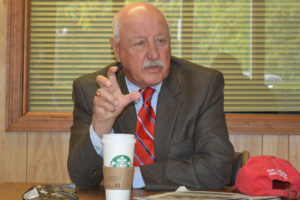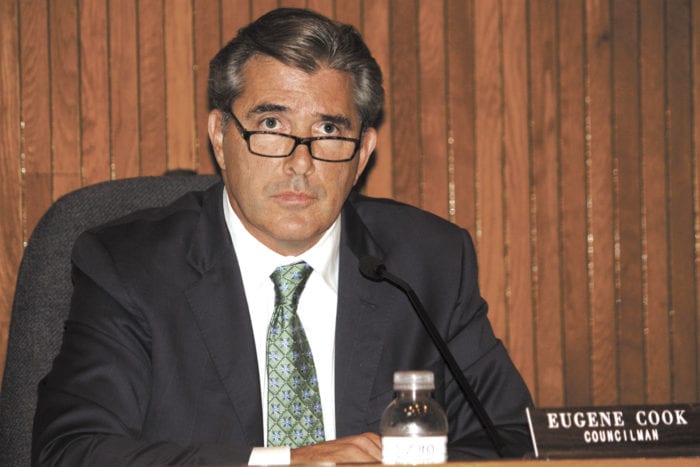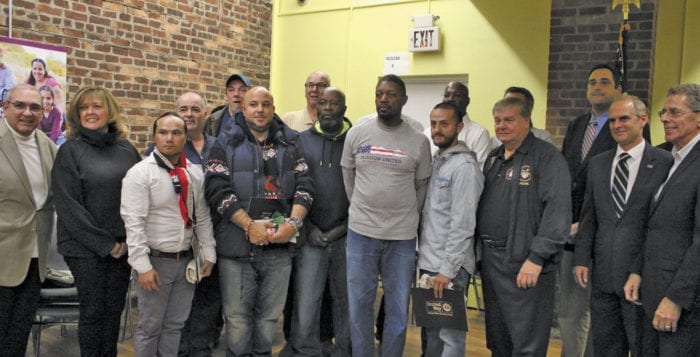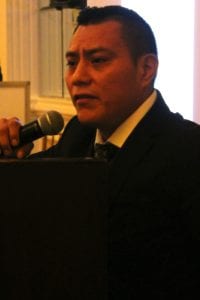A senior at Shoreham-Wading River High School was recently recognized as a hero for helping to save the life of her best friend over the summer.
Jillian Dinowitz snapped into action when she heard Ryan Magill screaming.
It was Aug. 9 and Dinowitz, 17, was in a powerboat on Moriches Bay giving sailing lessons to kids, ages 8 to 12, as an instructor at the Moriches Yacht Club. Her lifelong friend Magill, 17, who was instructing kids in another boat, had fallen overboard and was wailing and thrashing in red water. His left arm and pectoral region had been severely cut by the boat’s propeller.

Dinowitz, joined by another friend and instructor, rushed over to Magill, pulled him out of the water by his life jacket and got to work. As the boat sped back to shore and emergency services were called, Dinowitz focused on keeping her friend calm and awake while Katlyn Lindahl, 18, made a tourniquet out of a towel and T-shirt. Dinowitz and Lindahl pressed it tightly against his blood-soaked arm.
“I honestly don’t know how I did it — it’s kind of a blur,” said Dinowitz, who admitted to feeling queasy at the sight of blood. “I would’ve done this for anybody in the water but just seeing that it was somebody so close to me, I kind of held myself together and just tried to stay strong for him. He’s the one that needed help at the time.”
Lindahl said while the two of them have had first aid training, their actions were entirely based on instinct.
“This was definitely a fight or flight thing,” she said. “There was no time at all really to think about what to do.”
Once back on land, Magill, a senior at Center Moriches High School, was emergency airlifted off the property to Stony Brook University Hospital. There, he underwent major surgeries. The doctors had to take a nerve out of his leg and transplant it into the damaged part of his shoulder.
They told him that if the girls hadn’t acted as quickly and effectively as they did, there was a good chance he could’ve died from blood loss or, at best, lost his arm.
“The difference they made was the difference between me being here and me not being here,” said Magill, who has since been slowly but steadily on the road to recovery. While he has trouble with menial tasks like tying his shoes and must wear a brace, he said he’s regained 50 percent of movement back in his arm and shoulder. “I’m doing very well, actually, and it’s thanks to Jillian and Katlyn. They literally saved my life and I’m in debt to them forever.”
His mother, Heather Magill, said her son has been incredibly positive throughout the entire experience and can be seen smiling every day no matter how tough things are.
“We’re in awe of him,” she said.
“After the accident, when we went to visit him in the recovery room, he said to my husband and me, ‘I love you guys … I need you to get me my phone, I have to call Jillian and Katlyn and tell them thank you for saving my life.’”
— Heather Magill
Magill’s and Dinowitz’s mothers, who have been best friends since high school, said the two teens have been inseparable since they were born. They joined the yacht club together when they were 7.
“I know in my heart there’s not a thing [Jillian] wouldn’t do for him in this whole world,”Heather Magill said. “It’s a testament to their friendship. We love her like family. After the accident, when we went to visit him in the recovery room, he said to my husband and me, ‘I love you guys … I need you to get me my phone, I have to call Jillian and Katlyn and tell them thank you for saving my life.’”
But for Jillian Dinowitz, it’s all about Ryan Magill getting back to his old self.
“When I visited him the day after the accident, it really hit me that something really serious happened, but it turned out okay and things are going to be better from there,” she said. “It’s amazing that he’s never gotten down about himself through all of this and has always been positive and willing to work hard to be where he was before the accident. It’s so inspiring.”
Nearly four months after the incident, on Nov. 28, the Shoreham-Wading River board of education honored Dinowitz, an Advanced Placement student and member of the school’s varsity tennis team, for her heroism, dedication and courage. As it happened in Center Moriches, Dinowitz said nobody at the school really knew about the incident, but it felt good to be recognized.
“Our true character often shines the brightest when we’re thrust into challenging circumstances,” high school Principal Frank Pugliese said of Dinowitz. “When that happened to Jillian this past summer, she rose to the occasion and helped to save a young man’s life. The entire Shoreham-Wading River community is so incredibly proud of her for her quick thinking and brave actions.”
























